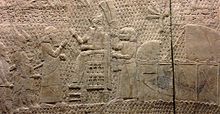
Back Lachisch-Relief German Bajorrelieves de Laquis Spanish תבליט לכיש HE Relief Lakhis ID Relevos de Laquis Portuguese
| Lachish reliefs | |
|---|---|
 The single inscription which identifies the location depicted in the reliefs reads: "Sennacherib, the mighty king, king of the country of Assyria, sitting on the throne of judgment, before (or at the entrance of) the city of Lachish (Lakhisha). I give permission for its slaughter". Identification number: BM 124911 | |
| Height | 5.1 meters |
| Width | 12 meters |
| Created | c. 681 BC |
| Discovered | c. 1846 Mosul, Nineveh, Iraq |
| Discovered by | Austen Layard |
| Present location | London, England, United Kingdom |
The Lachish reliefs are a set of Assyrian palace reliefs narrating the story of the Assyrian victory over the kingdom of Judah during the siege of Lachish in 701 BCE. Carved between 700 and 681 BCE, as a decoration of the South-West Palace of Sennacherib in Nineveh (in modern Iraq), the relief is today in the British Museum in London,[1] and was included as item 21 in the BBC Radio 4 series A History of the World in 100 Objects by the museum's former director Neil MacGregor. The palace room, where the relief was discovered in 1845–1847, was fully covered with the "Lachish relief" and was 12 metres (39 ft) wide and 5.10 metres (16.7 ft) long.[2] The Lion Hunt of Ashurbanipal sequence was found in the same palace.
- ^ "Room 10b: Assyria: Siege of Lachish". British Museum. Retrieved 2012-10-03.
- ^ "The Lachish Reliefs and the City of Lachish" (PDF). Ericlevy.com. Retrieved 2012-10-03.
© MMXXIII Rich X Search. We shall prevail. All rights reserved. Rich X Search